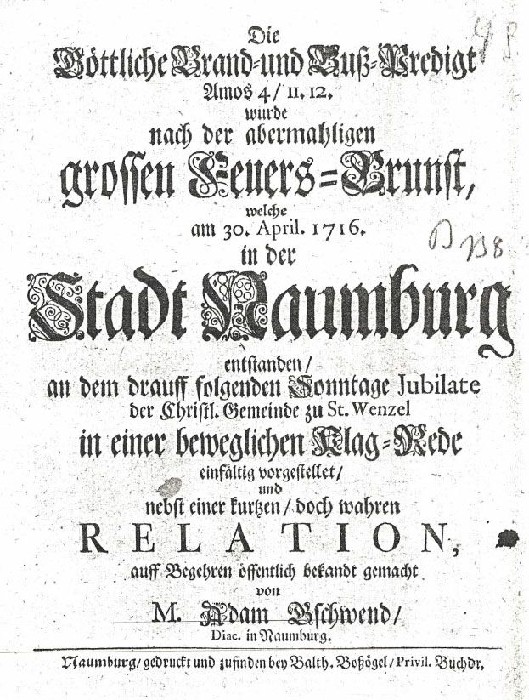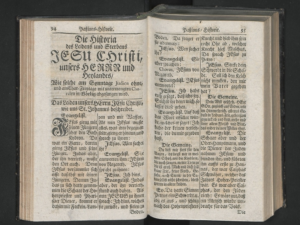Anyone studying the work of hymnologists in the early 18th century will come across many different names. We have traced their publications, which already reveal the cohesion and intensive co-operation of this group, which called itself “Lieder-Freunde”. Important names include Johann Christoph Olearius from Arnstadt, Georg Heinrich Götze from Lübeck (who supported Buxtehude in his evening music ‘Abendmusiken’!) and Johann Martin Schamelius from Naumburg.
Lydia Vroegindeweij studied the strong relationship between the text and music in Bach’s choral cantatas and the work of these early hymnologists and explored the question. Is the relationship between Bach and these Lieder friends documented anywhere? The most verifiable relationship to Bach’s work can be found in Schamelius’ hymnal commentaries ‘Evangelischer Lieder-Commentarius’. He wrote an autobiography, which was published by his son-in-law after his death, but unfortunately it offers no concrete evidence.
An extraordinary text in a funeral poem!
But … Surprise! After Schamelius’ death in 1742, a funeral poem was apparently written in which his work as a hymnologist is extensively sung about. It contains the names of the “Lieder-Freunde” with whom he worked.
Under the biblical motto “And they sang the song of Moses and the song of the Lamb”, the Secunda of the Council School in Naumburg dedicated an epicedion (funeral poem) to Schamelius entitled “”Die Verdienste der Lieder=Dichter und Erklärer” (The Merits of the Song Poets and Explainers). This poem is a rhymed song story. The hymn of praise to the biblical singers Moses, Miriam, Barak, David, Mary and Zechariah is immediately followed by the songs of the Reformation and the role of Schamelius’ contemporaries in them:
Des Luthers Glaub und Gerhards Geist,
Bachs, He[e]rmanns und der Franken Triebe
erwecken das was christlich heist,
und zeugen Hoffnung, Glaub und Liebe.
Neumeisters, Schmolkens, Brokes Gluht,
in der der Andacht Stärke ruht,
verewiget durch Rambachs Feuer,
und lenkt der Neuern Harfen=Spiel
auf das von Gott bestimmte Ziel
und macht ihr Dichten werth und theuer.
Was Olears und Serpils Fleiß,
was Wezels Müh in Achtung sezet,
was Lilienthals und Buschens Preis,
nach Recht und Pflicht in Marmor äzet,
erhöhet Schamels Rettungs=Licht,
das aus der Andacht Quelle bricht.
Der Nuz der Lieder=Dichter Leben,
der Lieder=Gloßen edle Zahl
erwerben Ihm ein Ehrenmahl,
das Ihm kein Künstler ie gegeben.
Dieß, und der frommen Reden Kraft,
rührt auch der Musen treuen Orden.
Drum ist auch ihre Leidenschaft,
durch dieses Klaglied kenntbar worden.
Welch ungewohnter banger Schmerz
beklemt nicht unsers Mitleids Herz!
Soll Schamel von der Seite scheiden?
Soll uns sein Nachdruck und sein Geist,
der Ihn der Zeitlichkeit entreist,
nicht länger in dem Tempel weiden?
Jedoch sein Heiland, der stets lebt,
heist Ihn bey sich das Leben schauen.
Sein Geist, der in den Schriften schwebt,
gehört vor jene Sternen=Auen.
Dieß tröstet der Betrübten Herz,
dieß lindert Deren harten Schmerz,
die sich, bey stummen Seufzern kränken.
Noch eins ist, was den Trost anhäuft:
wer Schamels Lieder=Schatz ergreift,
verneuert auch sein Angedenken.
The names of Lieder-Freunde mentioned
This funeral poem mentions several names of the Lieder-Freunde.
Who are they?
- Johann Sebastian Bach (1685-1750)
- August Hermann Francke (1663-1727)
- David Heermann (1655-1720) (Although the text contains the name “Hermann”, it seems likely that Heermann, a contemporary and hymnologist, is being referred to here)
- Barthold Heinrich Brockes (1680-1747)
- Erdmann Neumeister (1671-1756)
- Benjamin Schmolk (1672-1737)
- Johann Jakob Rambach (1693-1735)
- Johann Christoph Olearius (1668-1747)
- Georg Serpilius (1668-1723)
- Johann Kaspar Wetzel (1691-1755)
- Michael Lilienthal (1686-1750)
- Peter Busch (1682-1744)
The source is unfortunately ... burnt!
Schamelius was already badly affected by fires during his lifetime. The great town fire in Naumburg on 30 April 1716 cost him his house and his library.
The source of this poem of mourning after his death unfortunately suffered the same fate. The catalogue reports: “Fire damage due to library fire in 2004”. It was kept in the Duchess Anna Amalia Library in Weimar and was irreparably damaged in the devastating fire in 2004 and is therefore unfortunately no longer available. Fortunately, it was quoted in Andreas Lindner’s dissertation from 1998, so that we can still take note of it.
Source: Andreas Lindner, Leben im Spannungsfeld von Orthodoxie, Pietismus und Frühaufklärung. Johann Martin Schamelius, senior pastor in Naumburg (1998).
Update:
The full paper can be read here, thanks to Prof Andreas Lindner from Göttingen, who transcribed the full text during his PhD research in the 1990s and was kind enough to send us his paper.






